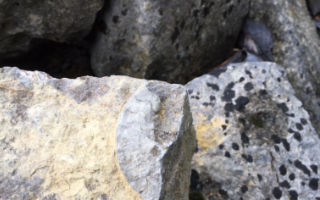Everyone’s talking about terroir, we’re talking about Trias. The Lower Franconian wines do not only grow on one kind of soil. We have three very different types of soil within our region: Buntsandstein, Muschelkalk and Keuper. Together they are called the “Franconian Trias”. And that is also the reason for our great variety of excellent wines.
It took millions of years for the soil to emerge from primeval seas. Around 240 million years ago, today’s Bundsandstein was created through deposits of rivers. The stone contains due to this a lot of iron. The next layer, the Muschelkalk, was created around 30 million years later. The Mediterranean Sea today had its deepest point here in the region. And when the sea slowly retreated, mussels, oysters and cephalopods died and were deposited. Therefore, the stone is very minerally. The top layer, the Keuper, was created up to 180 million years ago. The constant change between sea, brackish water, swamp and dry seasons finally led to a warm, humid climate and lush vegetation. Many dying plants deposited in the interplay of dry and wet phases. Therefore, the soil is rather spicy.
You can imagine it like a sandwich: at the bottom the Bundsandstein can be found, the oldest layer of the Trias, followed by the Muschelkalk and finally the Keuper as third layer. When the Upper Rhine Trench collapsed around 30 million years ago, in the final phase of the unfolding of the Alps, the pressure on the layers of the Trias was very high why the individual parts of the sandwich were standing crocked due to tectonic elevations and depressions. Over the time, the erosion exposed the various layers: the coloured sandstone, the limestone and Keuper – together also called the Franconian Trias.
Around two million years ago, the Main made its way through the rock, today the lifeline of our region, creating steep slopes that today rank among the top locations in Franconia (Iphöfer Julius-Echter Berg, Homburger Kallmuth, Randersackerer Pfülben, Würzburger Stein, Escherndorfer Lump). Many of our best gropes growth nowadays on this sunny slopes. The so-called Trias sediments covers around 90 percent of Lower Franconia wine region. And due to this, we grow today our wines on soils that are hundreds of millions of years old. And this special soil composition creates wines with a specific taste.
These different types of soil are the reason why Franconia produces so many different wines in such a small space: Buntsandstein is the perfect soil for our full-bodied, round red wines – especially Pinot Noir, Domina and Dornfelder, which are mainly found on the so called Untermain, around Bürgstadt, Großheubach and Klingenberg. In the region around Würzburg, the soil is ideal for very mineral, aromatic white wines such as Silvaner and Müller-Thurgau, Bacchus. And in the region around Iphofen, where mainly the Keuper can be found, we produces spicy white wines and excellent Rieslings.
A wine tour through Franconia opens up a very special world of fine wines. And whoever comes to us has the opportunity to taste many wines of very different characters. A wine universe in a very small space – thanks to the Franconian Trias (the skill of the winegrowers and the good weather of course, too)!
